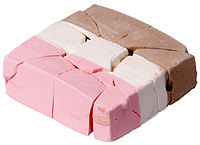
Photo from wikipedia
The stability of microorganisms along the time is important for allowing their industrial use as starter agents, improving fermentation processes. This study aimed to evaluate the survival and maintenance of… Click to show full abstract
The stability of microorganisms along the time is important for allowing their industrial use as starter agents, improving fermentation processes. This study aimed to evaluate the survival and maintenance of the cell viability of the lactic acid bacteria Lactobacillus fermentum IAL 4541 and the yeast Wickerhamomyces anomalus IAL 4533, both isolated from wheat sourdough, after lyophilisation with different cryoprotectant and storage at room temperature along a year. Treatments involved adding control solution (S1 = 0.1% peptone water), and four cryoprotectant solutions S2 (10% sucrose), S3 (5% trehalose), S4 (10% skim milk powder) and S5 (10% skim milk powder plus 5% sodium glutamate) to the microbial cells previously of freeze drying processing. To verify the effect of lyophilisation on the number of microbial cells recovered, microbiological analyses were performed and cell viability was calculated before and after lyophilisation and regularly during a storage period of 365 days at room temperature. Viability after freeze-drying was influenced by the cryoprotectant agent employed, as well the microbial stability conferred along the storage. Differences on the microorganism response to some protectors were observed between the lactic acid bacteria and the yeast evaluated. W. anomalus was more affected by absence of cryoprotectant (S1) during freeze drying processing, but this microorganism was more stable than L. fermentum along the storage without the presence of protectant agents. For L. fermentum, S5 was the best protectant, allowing the recovering of 100% of the bacterial cells after lyophilisation and 87% of cell viability was observed after one year storage, followed by S4 (96 and 74%, respectively). S4 and S5 were the best protectant to W. anomalus (viability >80% after 1 year), but no increase in the yeast cell viability was conferred by addition of glutamate (S5) to skim milk. After 1 year of storage, trehalose was much more effective on protection of the yeast than bacteria (72% and 7% of viability, respectively). S2 was the less protectant agent among the tested, and their effectiveness was higher in L. fermentum (allowing 14% of cell recovering up to 120 days of storage) if compared to W. anomalus (25% of viability until 90 days of storage). Our results demonstrate that freeze-drying is a realistic technology for the stability and maintenance of the potential sourdough starter L. fermentum and W. anomalus for long time; however, the choice of cryoprotectant will influence the process effectiveness.
Journal Title: Food research international
Year Published: 2019
Link to full text (if available)
Share on Social Media: Sign Up to like & get
recommendations!